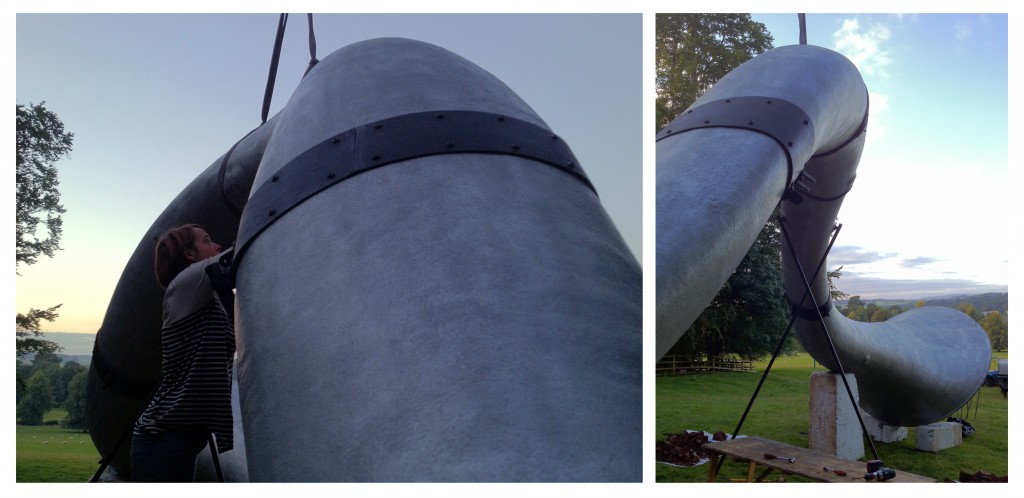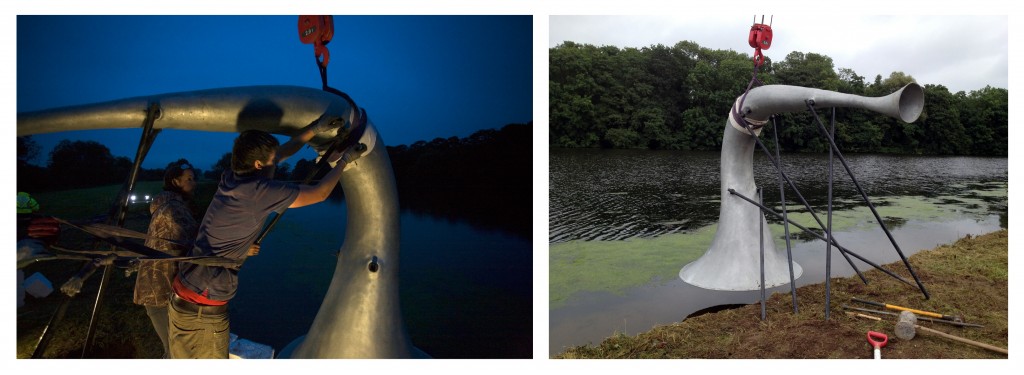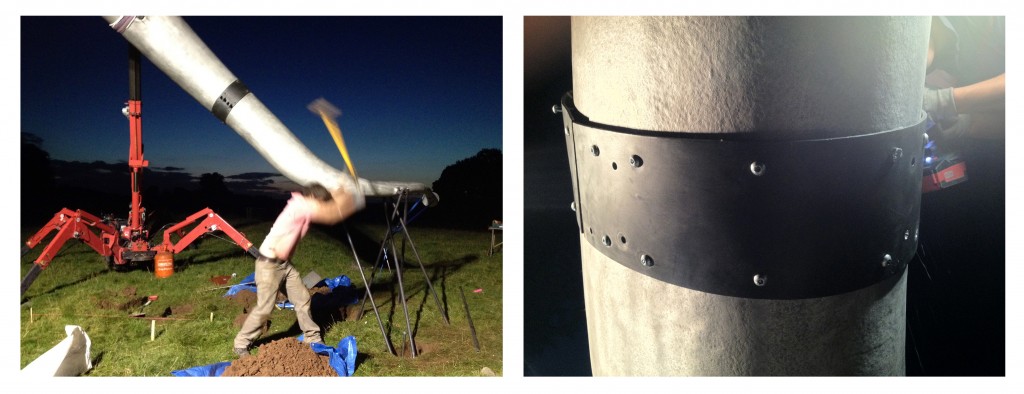Client: Studio Weave / The National Trust
Artist: Studio Weave
Fabrication: AB3 Workshops
Installation: AB3 Workshops
Structural engineers: Structure Workshop
Time frame: July – September 2012

Perhaps different in many ways to other works designed by Je and Maria at Studio Weave, these four forms were envisioned to sit quite starkly in the comforting green surrounds of the national trust property – Kedlestone Hall. The forms take on distinctly trumpet-like shapes; twisting, curling and expanding in their length. Whilst as immature objects in the workshop they retained something of the organic, with growth and development in their shape, stood underneath them or taking in their profile, it is in their finished state, with structural fixings and uneasy cradled placement that the oddity of their existence surfaces. A waxed tin-zinc surface draws us towards the modern, the futuristic even, awakening thoughts of otherworldly prototyping. It was not until we installed them, observing them sitting precariously on their heavy contorted bellies in amongst the fauna, on a hilltop or overhanging the still water, that they felt far from a place of time to come. These beasts it seems are from a place of secrecy, an experiment that has until now been hidden from our eyes, suddenly devoid of function – if ever there was one, they are are wheeled out to be admired as lost monuments, like the empty fuselage outside the aerodrome, the here hears will remind the surrounding land of places where things are shaped and formed in quite a different way.

The tender had been won prior to my arrival at Ab3, with the preliminary investigations into possible methods of fabrications already underway. To generate the forms it was decided at an early stage to use the workshop’s 5 axis Kuka robot. With some preliminary CAD work done by the ever faithful Inigo Dodd – also the robot operator, the four pre-modelled forms could be broken down into manageable individually shapes and milled from polystyrene. Once carved the shapes would be assembled together, thus resembling the initial CAD drawings. Simply put, the 5 axis robot will interpret a digital three dimensional form, and with the use of a high-spinning tool fixed at the end of the arm using a pre determined path, will slowly carve – working it’s way around the material – until the shape is replicated physically. It is a remarkably exact science.
Having completed the initial CAD work and milling – a lengthy part of the process it indeed was, running at a little over a month – the next phase would involve the moulding of hollow fibreglass sections that would come together to create the final objects. Taking our solid polystyrene formas or patterns as they are sometimes called, the surface can be sanded, sealed and then built up with layers of polyester resin and fibreglass matting, achieving a structurally sound pre-determined thickness. This glassing process was subcontracted out to Fibre Sports, in the capable hands of Steve Foster. Due to the size of the objects, ranging from 3 – 12 meters in length, it was decided early on in the pre-production process that where needed the forms would be broken down into sections, allowing for ease of transport and manoeuvrability. Working closely with Studio Weave and our patient engineers – Structure Workshop, a custom fabricated aluminium ‘collar’ joining system was developed, each join consists of a fixed inner non-visible collar and an exterior collar. The interior collar, made up of 3 – 4 rolled sections of 5mm ø aluminium sheet and several extra strength sections of 10mm ø bosses, would be affixed to the inner contours of the fibreglass object section. The corresponding object section would then be aligned and fitted over the inner collar, being temporarily held in its fitted position. The exterior collar – rolled in two separate aluminium sections – would then be fitted over the join, in which position it could drilled through to the inner collar. The holes would then be tapped with a 10mm ø thread, allowing for a bolted pre-assembly / disassembly in the workshop and then again on site.
Looking beyond the solid objects to methods of erection and fixing, the design specified by Studio Weave involved finding a way to elevate each of the sculptures. The differences in shape and orientation between the 3 large forms made for a considered approach both from a structural perspective and an aesthetic one. The erraticism of the shapes presented problems in relation to easily defining load bearings and weaknesses in the fibreglass and both Studio Weave and ourselves as fabricators were keen to find a uniformity though the fixings and supports. The forms would be supported by a series of Circular Hollow Section steel poles of varying lengths, depending upon their fixing locate. Two pole diameters were specified. A uniform fixing was designed to be laser cut in steel, incorporating a circular base plate with a central hole and two welded lugs would that would then act as a cradle to hold the pole in position via an 8mm bolt, this would be used for both the main body and ground fixings. This ‘eyelet’ design is a beautifully simple and seductive feature and we have the Structure Workshop team to thank for this. To achieve a structurally sound fixing on the body, a further circular plate with a larger diameter – again with a centrally tapped hole, would be affixed to the main body then fibreglassed over, leaving a section of studding in so as not to wreck the threads. The fibreglass was subsequently worked back by hand so as to blend smoothly into the form of the object.
Pre-fitting all of the fixing components in the workshop was essential prior to the installation phase. By suspending the sculptures in the yard, positioned in their final height and orientation, the exact positioning of the eyelets could ascertained working from measurements set out in drawings generated by the engineers. In conjunction to this, a grid could be laid out below the forms, thus determining the ground fixing position and necessary length of each individual CHS pole. The forms could then be broken down into their component parts with the eyelets removed, and sent off for the Thermal arc process, this would supply the final metalised finish prior to being sent up to Derby for the installation. Lee Hollyoake and his team at Metalising Solutions took responsibility for this part of the finishing process, working very quickly on some awkward shapes. This process involves atomising the molten metal particles then firing them at the desired surface, they solidify giving it a thin ‘skin’ and the metallic appearance. Using a tin zinc finish – as opposed to a straight zinc – allowed for a better finish in the burnishing of the surface, a process by which the material is worked back with abrasives to bring in up to a brighter shine.
Photography © Tom Colebrook 2012










